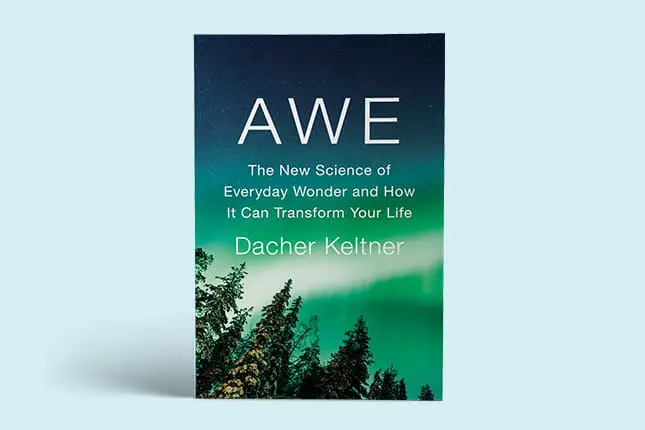Awe: The New Science of Everyday Wonder and How It Can Transform Your Life
By Dacher Keltner
Penguin Press, 2023
It takes a lot of courage and creativity to research the ineffable, but Berkeley psychologist Dacher Keltner has managed to do just that. To be honest, I was skeptical that scientists could study awe, or that I wanted them to. My experiences of wonder were sacred, and I didn’t necessarily care to have them parsed. However, as I read Awe: The New Science of Everyday Wonder and How It Can Transform Your Life, I realized that I could learn from this research and still experience awe unimpeded by my newfound scientific knowledge.
Keltner, a professor of psychology at the University of California at Berkeley and faculty director of the university’s Greater Good Science Center, is an excellent writer with a prodigious knowledge of anthropology, religion, literature, and art. The author of Born to Be Good and The Power Paradox, he has spent his professional life exploring psychology’s fundamental questions, including these from Awe: “How do we live the good life? One enlivened by community and meaning, that brings us a sense of worth and belonging and strengthens the people and natural environments around us?”
Keltner defines awe as “the feeling of being in the presence of something vast that transcends your current understanding of the world.” In his surveys of Chinese and American people, he’s found that most of us experience awe frequently and that, with curiosity, intentionality, and mindfulness, we can orchestrate more awe for ourselves. Indeed, that’s Keltner’s goal for this book.
His research suggests that eight primary wonders evoke awe: moral beauty, collective effervescence, nature, religious experiences, art, music, birth, and death. By far, the most commonly experienced wonder is moral beauty, defined as the courage, kindness, and strength of ordinary people. For example, Keltner was awestruck by his brother Rolf’s moral beauty as he lay dying of cancer. He describes the light radiating from his brother’s face as he bravely and peacefully approached death.
Nearly all of us have experienced “collective effervescence,” Émile Durkheim’s term for an awe-inspiring sense of “we.” This can be experienced in religious settings, at family or sports gatherings or, in my experience, in activist groups where we are all united in a strong sense of common purpose. Keltner gives the example of Burning Man, the annual festival in Nevada that’s designed to inspire collective effervescence via music, art, rituals and, in many cases sex, alcohol, and hallucinogens. He writes, “Desert sunrises and sunsets begin and end each day with the whoas and aahs of appreciative observers. Music and dance move people into patterns of collaboration, openness, and curiosity throughout the day. Trippy, immersive art installations astonish throughout the pop-up city.”
Nature is where I’m likeliest to feel awe. I’ve experienced it watching the Sandhill crane migration, moonrise over the prairie, and the Perseid meteor showers. Comet Hale-Bopp presented me with many opportunities for awe. During its time of visibility in 1997, I was on a stressful book tour and ragged from anxiety. As I rode in a taxi to my hotel or flew from one city to the next, Hale-Bopp could bring me to tears and calm me down. Comet therapy.
I recall an incidence of both nature and collective effervescence-inspired wonder. In 2015, on the day of the full solar eclipse, a large group of people lined the dam near my home. We sat in lawn chairs waiting for the great moment of near-total darkness. When it took place, I could hear, all along the dam, the spontaneous collective intake of breath followed by the word, whoa. Afterward, people were jubilant, hugging total strangers and marveling about an experience that words couldn’t capture.
Before hominids learned to speak, they may have made music. It has long been part of sacred ceremonies, healing rituals, and celebrations. Likewise, we’ve made art for at least 100,000 years. Monet’s paintings of snow and Leonard Cohen’s songs fill me with wonder. When my heart is frozen in grief and I play Lucinda Williams’s “Sweet Old World,” my heart melts at its beauty and I can at last cry.
Religious experiences often connect us to the vast and mysterious. While sitting under the Bodhi Tree, Buddha woke to the interconnected and fully awake universe. In fact, religions may have been invented to explain and perhaps to replicate experiences of awe. Emerson’s view was to eschew organized religion and go outdoors to find wonder. After a week in silent retreat at Spirit Rock Meditation Center, I was in a state of bliss. As I walked into the San Francisco airport to fly home, I worried that the crowds would somehow erase my exalted state. Instead, I found myself wishing that I could hug every person and ask, “Do you know how perfect and beautiful you are?”
As are all emotions, awe is embodied. It activates the vagal nerves, which slow our heart rate and deepen our breathing, and it triggers the release of oxytocin, which promotes trust and a sense of well-being. The three physical markers for all kinds of awe are chills, tears, and vocalizations of wow or whoa. With awe, our default mode network, or what Buddhists call “monkey mind,” is silenced, and our minds open in wonder to the interconnectedness of life. We sense our smallness in relationship to something vast and mysterious. Such moments have the power to shift our perspective and spur spiritual and emotional growth.
Keltner’s book is full of experiments. In one, he asked two groups of people over age 75 to walk every day. One group was encouraged to walk vigorously and the other to take “awe walks,” which involved looking at the world with fresh eyes and taking moments to appreciate the vastness of things, such as a panoramic view or the patterning of a leaf or insect. Participants then reported their emotions and sense of well-being. The awe-walkers were significantly happier and more relaxed. Keltner found that the more weeks the participants took their awe walks, the more wonder they experienced. And, when the people in this group were tested later, they reported less anxiety and depression and more joy.
My favorite story in the book is about photographer Rose-Lynn Fisher’s work with sacred geometries. She is inspired by the microscopic and has photographed snowflakes and bees. In a recent project, she placed on slides tears she cried when she was angry, in pain, grieving, or happy. She then photographed the tears for a book called The Topography of Tears. The lines, shapes and patterns of the tears revealed the geometry of her feelings. Indeed, tears for various complex feelings have different neurochemical profiles.
Whoa!
Much as I respect Keltner’s research, I find myself wondering whether his subjects could distinguish awe from amazement, joy, appreciation of nature, and love of beauty. I am not sure that I can do this. I also wondered about demand characteristics. Did he ask his subjects to report awe, specifically? I questioned the difference between awe and what Maslow called “peak experiences” or what David Yaden at Johns Hopkins calls “self-transcendent experiences.” Keltner’s research with a colleague located awe in a separate semantic space, but can we humans actually do this?
Regardless, Keltner’s work has many implications for therapists. He speculates that awe could be an antidote for isolation, narcissism, and the stresses of modern life. He believes that today’s teenagers have been particularly awe-deprived and that, with more experiences of wonder, they would suffer less depression, anxiety, self-harm, and eating disorders.
Awe can not only lessen anxiety and depression, but also increase joy, trust, and prosocial activity. Perhaps we can work to orchestrate more wonder in our clients’ lives. For example, often when couples come in for therapy, we strive to strengthen communication skills, increase understanding, and resolve conflicts. All worthy goals. However, if we included increasing shared awe, we might find our couples more bonded and relaxed.
We can ask our clients to keep track of their experiences of awe and to share them with us. We can encourage them to be on the lookout for moral beauty, collective effervescence, and all the other wonders of life. We can inspire awe in our offices with books, art objects, and music. (I recommend the Prelude to Bach’s Cello Suite No. 1 in G major.) We can accompany our clients to awe-inspiring places, such as a nearby art exhibit or a place of natural beauty. We can work to orchestrate wonder by assigning such experiences as watching sunsets or taking awe walks. I suspect that if we can increase these kinds of moments in our clients’ lives, they will become calmer, healthier, and more connected to others. And, if we give these same assignments to ourselves, we’ll also benefit. Perhaps the antidote to burnout is awe.
Keltner’s goal of inspiring more awe was realized by at least one reader: me.
His work left me poised for wonder and amazement. That’s the highest compliment I can give any book.
Mary Pipher
Mary Pipher, PhD, is a clinical psychologist, author, and climate activist. She’s a contributing writer for The New York Times and the author of 12 books, including Reviving Ophelia, Women Rowing North, and her latest, A Life in Light. Four of her books have been New York Times bestsellers. She’s received two American Psychological Association Presidential Citation awards, one of which she returned to protest psychologists’ involvement in enhanced interrogations at Guantanamo.













